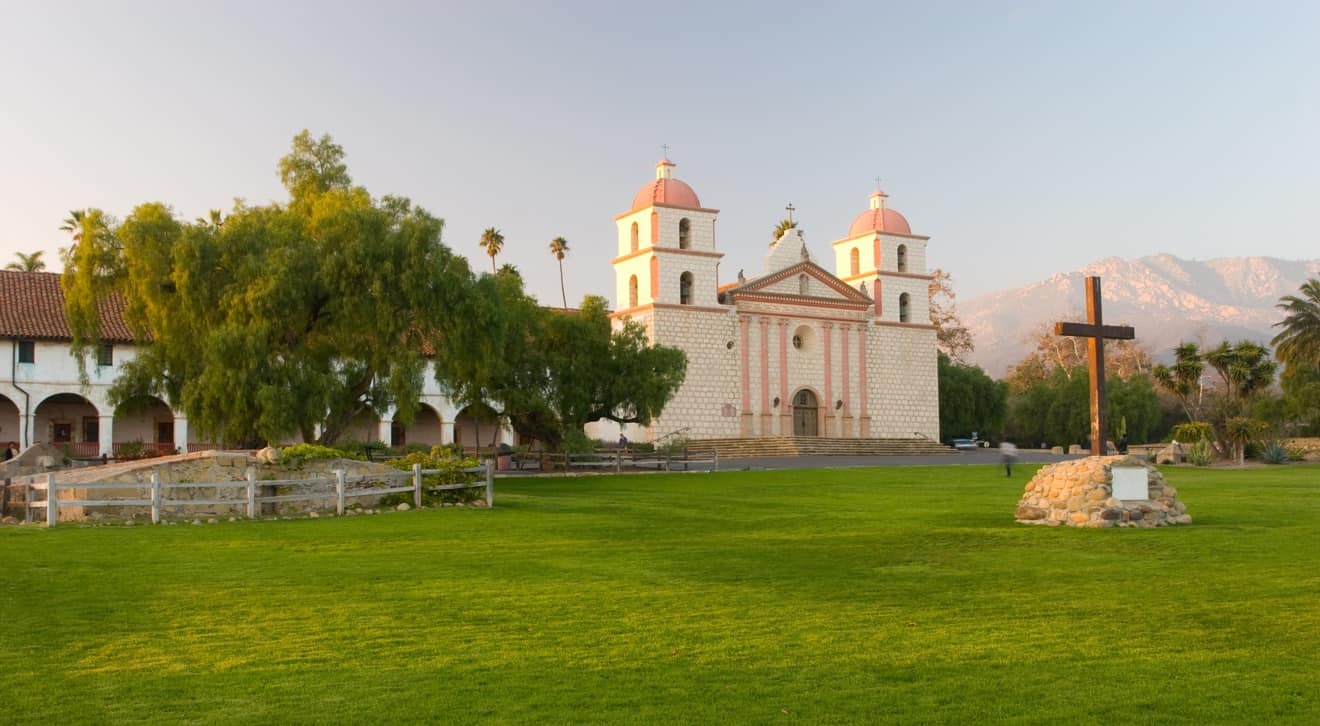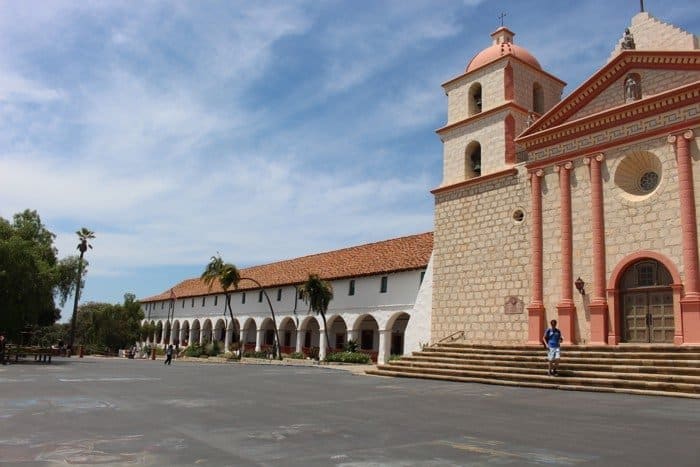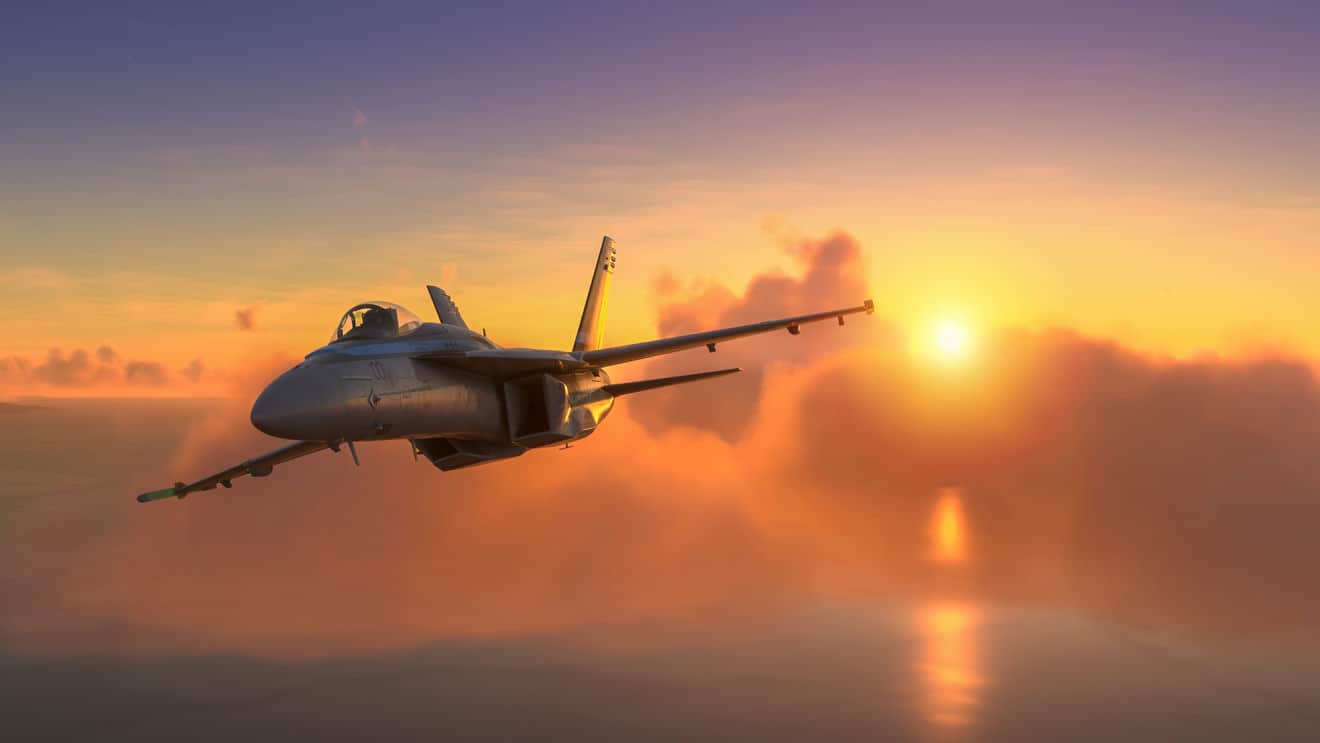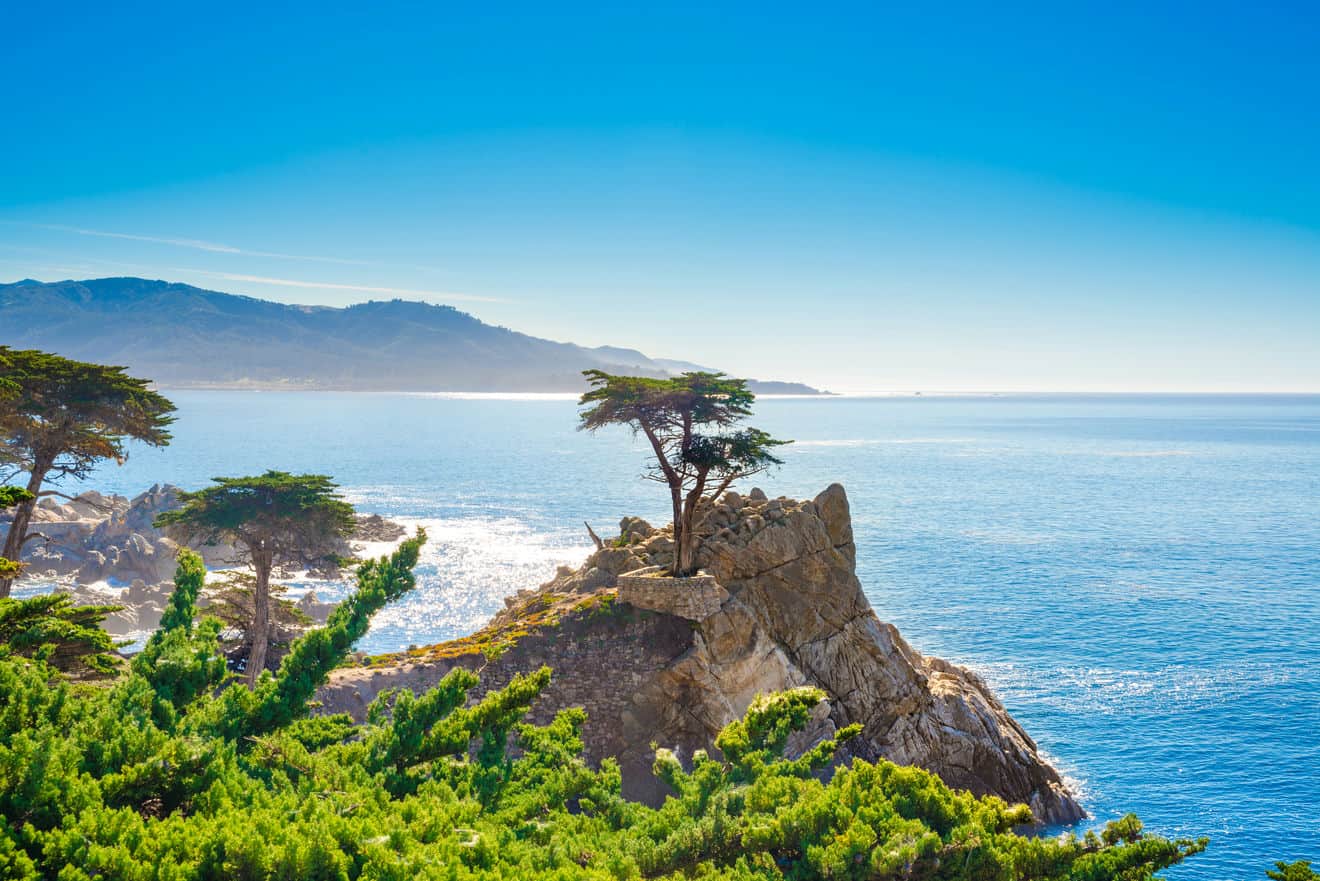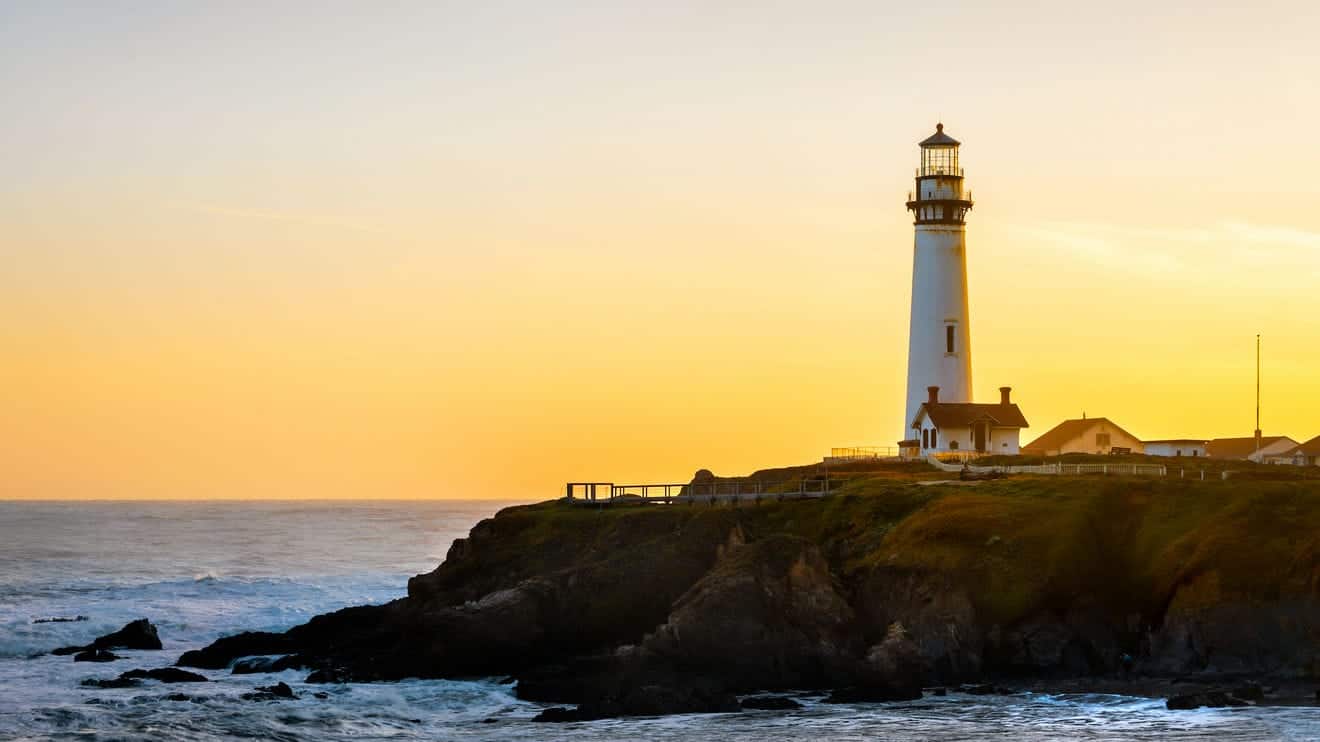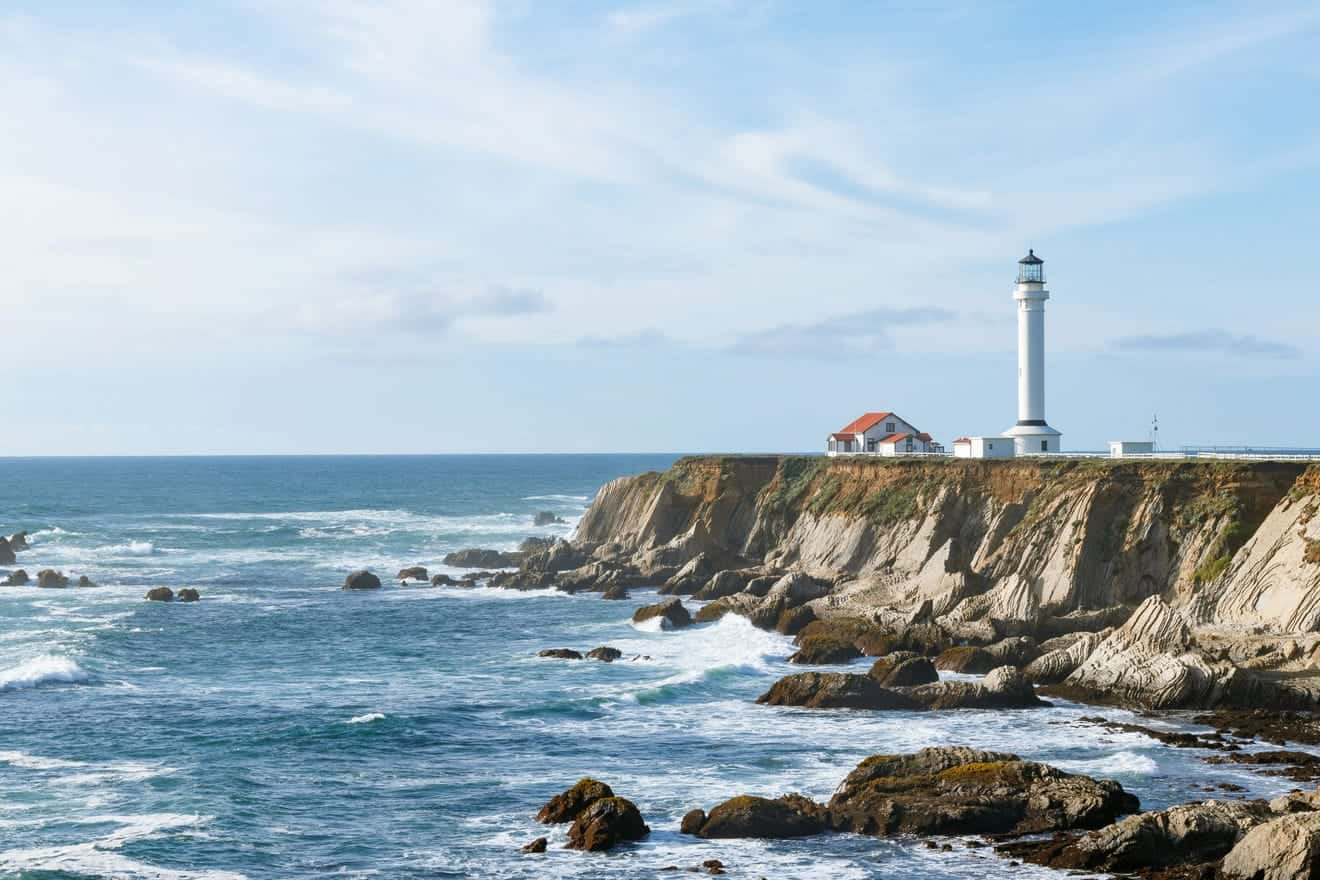Besides being a beautiful place with wonderful views, the California coast also treasures a rich history. Specifically, we are referring to the Franciscan missions that have developed along the entire coast of the Golden State. Today, the road that connects all of the Spanish missions is known as El Camino Real and runs mostly along U.S. Highway 101. The distinctive sign throughout the Camino Real that indicates that you are on the right road is the Franciscan walking stick topped with a bell.
 If you have already been to California, it is very likely that you have passed by the California missions during your travels, but if you are in the process of planning an itinerary, it is likely that after reading this article, you will want to add a few more stops! The person who was instrumental in the construction of these Franciscan missions is Father Junipero Serra, who, in 2015, was canonized as a saint of the Catholic Church by Pope Francis.
If you have already been to California, it is very likely that you have passed by the California missions during your travels, but if you are in the process of planning an itinerary, it is likely that after reading this article, you will want to add a few more stops! The person who was instrumental in the construction of these Franciscan missions is Father Junipero Serra, who, in 2015, was canonized as a saint of the Catholic Church by Pope Francis.
Contents
- Map and Information about California Spanish Missions
- Mission San Diego de Alcalá
- Mission Santa Barbara
- Mission Santa Inés
- Mission La Purísima Concepción
- Mission San Carlos Borromeo de Carmelo
- Mission San Francisco de Asís
- List of the Other California Missions
- San Luis Rey de Francia (County of San Diego)
- San Juan Capistrano (Orange County)
- San Gabriel Arcángel (Los Angeles suburbs)
- San Fernando Rey de España (Los Angeles)
- San Buenaventura (Ventura)
- San Luis Obispo de Tolosa (San Luis Obispo)
- San Miguel Archangel (San Miguel)
- San Antonio de Padua (Monterey)
- Nuestra Señora de la Soledad (Soledad)
- San Juan Bautista
- Santa Cruz
- Santa Clara de Asís (Santa Clara)
- San José
- San Rafael Arcángel (San Rafael)
- San Francisco Solano (Sonoma)
Map and Information about California Spanish Missions
Before I continue, let me give you a few helpful pointers. Most of the missions offer a similar experience. In addition to seeing the churches, you can also visit small museums (admission to the museums typically costs in the $5-10 range) that have collected historical artifacts related to the construction and life that took place in the missions. In addition, you can take a walk in the garden and cemetery of each mission and visit the missions’ gift shops.
For this reason, if you are traveling along the California coast, you should go to the missions that are more convenient to reach along your route or that are located in the cities or the areas that you have decided to visit. With rare exceptions, almost all of the churches are still in operation, so at certain times of the day, it may be appropriate to wait until the end of liturgical celebrations taking place before proceeding to visit the mission. Given the high number of missions along the Camino Real, we want to present to you those that we think are the most significant and closest to the places of interest on the California coast going from south to north. At the end of the article, there will be a complete list of all of the missions.
Mission San Diego de Alcalá
 The mission in San Diego is the first of the twenty-one Franciscan missions that were built along what would become the Camino Real. Father Junipero Serra founded this mission in 1769 and it was from here that Christianity began to spread throughout California. The church was destroyed twice in 1803 and 1812 due to earthquakes. Since then, it was rebuilt and you can still visit it today. This mission is the resting place of Father Luis Jayme, California’s first Christian martyr, which further confirms the historical significance of Mission San Diego.
The mission in San Diego is the first of the twenty-one Franciscan missions that were built along what would become the Camino Real. Father Junipero Serra founded this mission in 1769 and it was from here that Christianity began to spread throughout California. The church was destroyed twice in 1803 and 1812 due to earthquakes. Since then, it was rebuilt and you can still visit it today. This mission is the resting place of Father Luis Jayme, California’s first Christian martyr, which further confirms the historical significance of Mission San Diego.
 The small museum displays a collection of liturgical vestments and tools used while the mission was active. However, the most important artifact is a document dated 1862 signed by Abraham Lincoln. In this document, President Lincoln gave back the property of the mission to the Catholic Church after the land had been confiscated first in 1834 by Mexico and then by the United States (once the annexation of California was completed). In San Diego, you will also have the opportunity to visit a museum dedicated to Junipero Serra located inside Presidio Park.
The small museum displays a collection of liturgical vestments and tools used while the mission was active. However, the most important artifact is a document dated 1862 signed by Abraham Lincoln. In this document, President Lincoln gave back the property of the mission to the Catholic Church after the land had been confiscated first in 1834 by Mexico and then by the United States (once the annexation of California was completed). In San Diego, you will also have the opportunity to visit a museum dedicated to Junipero Serra located inside Presidio Park.
Accommodations near the Mission San Diego de Alcalá
Mission Santa Barbara
Mission Santa Barbara is one of the largest and most beautiful missions you’ll encounter along the Camino Real, so much so that it has earned the nickname of Queen of the Missions. Founded on December 4, 1786 by Father Fermín de Francisco Lasuén, the successor of Junipero Serra, it was named in honor of Saint Barbara, the Christian martyr whose memory was celebrated on that day. Later, it also became the name of the city that developed nearby.
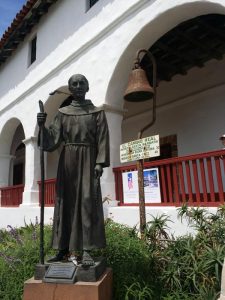 The construction of this mission was instrumental for the subsequent development of the area. For instance, some parts of the water system are still used today by the inhabitants of the city. In addition to the interior of the church, it is definitely worth it to visit the museum and the cemetery and to enjoy some peace and quiet in the cloister.
The construction of this mission was instrumental for the subsequent development of the area. For instance, some parts of the water system are still used today by the inhabitants of the city. In addition to the interior of the church, it is definitely worth it to visit the museum and the cemetery and to enjoy some peace and quiet in the cloister.
It should be noted that in the cemetery, there are the remains of Juana Maria, better known as the last woman who inhabited San Nicolas Island. She was a Native American woman who lived in complete isolation for almost twenty years on the island off the California coast and was the last member of the Nicoleño tribe. Her story became very famous in the United States thanks to the children’s book Island of the Blue Dolphins written by Scott O’Dell.
After visiting Mission Santa Barbara, there is more to explore in the city, such as the historic buildings and the picturesque waterfront. You can discover all of the attractions in Santa Barbara in our article about the things to see in Santa Barbara.
Accommodations near Mission Santa Barbara
Mission Santa Inés
Located in Solvang (a small Danish town in the middle of California!), this is one of the more recent missions built. In fact, it was founded on September 17, 1804. When you visit the garden, which is one of the most pleasant I’ve had the opportunity to walk through, you’ll find many varieties of plants and some traces of the mission’s past including the original seminary floor.
If you are interested, visit the museum, where you will find a remarkable collection of liturgical vestments, missals, and manuscripts of Gregorian chants. Along the path inside the mission, there are small speakers that can be activated to learn more information about the place you are visiting.
Accommodations near Mission Santa Inés
Mission La Purísima Concepción

This mission is part of California’s La Purísima Mission State Historic Park and is one of only two missions that are not owned by the Catholic Church. You can reach by heading north of the city called Lompoc on La Purisima Road. It is about twenty minutes drive from Solvang. It is worth visiting, because it is one of the few cases in which ten of the original buildings that characterized the life of the mission, including the church, the blacksmith’s store, the monastery, and the stables for livestock, have been restored, both externally and internally.
This makes it easier to understand what it was like to live and work in a mission in the early nineteenth century. If you want to visit it in its entirety, I recommend that you check the hours of operation. When I visited Mission La Purisima, I arrived in the area around 4:30 pm, only to discover that the park closes at 5:00 pm. Check on the official website to gather information to better plan your visit.
Accommodations near the mission La Purísima
Mission San Carlos Borromeo de Carmelo
Located on the southern outskirts of lovely Carmel-by-The-Sea, it is the second oldest mission, dating back to June 3, 1770. It is popular among tourists, given its convenient location, as well as pilgrims, since the church houses the mortal remains of Saint Junipero Serra. The cenotaph made of marble and bronze by Jo Mora in 1924 is also particularly interesting. It is a life-size depiction of Junipero Serra and three other friars whose remains are also buried in the church.
Inside the complex, there is also the large original wooden cross dating back to the period of construction of the mission and a plaque commemorating the visit of Pope John Paul II who came here in 1987 during his apostolic mission in the United States. If you decide to follow the Path of History in nearby Monterey, you will also see the Cathedral of San Carlos Borromeo, which was also founded by Serra as a mission chapel.
Accommodations near Mission San Carlos Borromeo de Carmelo
Mission San Francisco de Asís
 This is the Mission of San Francisco. Founded on June 29, 1776, it was built so well that the chapel was one of the few buildings to survive the terrible earthquake in 1906. Today it is considered the oldest building in San Francisco. The complex is also known as Mission Dolores because, at the time it was founded, a stream called Arroyo de los Dolores flowed nearby. Although most of the liturgical celebrations take place in the basilica next door, on some special occasions, the mission chapel continues to be used.
This is the Mission of San Francisco. Founded on June 29, 1776, it was built so well that the chapel was one of the few buildings to survive the terrible earthquake in 1906. Today it is considered the oldest building in San Francisco. The complex is also known as Mission Dolores because, at the time it was founded, a stream called Arroyo de los Dolores flowed nearby. Although most of the liturgical celebrations take place in the basilica next door, on some special occasions, the mission chapel continues to be used.
Accommodations near Mission San Francisco de Asís
List of the Other California Missions
After having described what we believe to be the most important and beautiful missions to see, we leave you with a brief description of the remaining ones (also in this case, they are listed from south to north), so that if you are planning a tour of the California coast you can consider a few more stops to see at least one of the missions, which are some of the most important historical buildings of the region.
San Luis Rey de Francia (County of San Diego)

Mission San Luis de Francia was completed in 1798 and was the thirteenth mission to be built. Given its size, it was nicknamed the King of the Missions. The unique feature of the inner garden is the first pepper tree in California.
San Juan Capistrano (Orange County)

San Juan Capistrano dates back to November 1, 1776, and it was the seventh mission to be built. Today, only the small whitewashed chapel remains and you can admire its interesting frescoes (it is considered the oldest church in California) and the breathtaking ruins of the large main church. The more modern part, however, is also very fascinating and it is worth spending time walking around in the gardens, under the walkways, and in the newer buildings.
San Gabriel Arcángel (Los Angeles suburbs)
 Located in the Greater Los Angeles Area, this is the fourth oldest mission. It was founded on September 8, 1771 by Junipero Serra, and what makes it unique are the six bells on the side overlooking Plaza Park.
Located in the Greater Los Angeles Area, this is the fourth oldest mission. It was founded on September 8, 1771 by Junipero Serra, and what makes it unique are the six bells on the side overlooking Plaza Park.
San Fernando Rey de España (Los Angeles)
 In this mission, the seventeenth mission completed in 1797, it is not uncommon to encounter beautiful peacocks wandering nearby. The tomb of famous American comedian Bob Hope is located in the adjacent cemetery.
In this mission, the seventeenth mission completed in 1797, it is not uncommon to encounter beautiful peacocks wandering nearby. The tomb of famous American comedian Bob Hope is located in the adjacent cemetery.
 San Buenaventura was the ninth mission to be completed and it was built on the occasion of Palm Sunday in 1782. Its construction had a very troubled history due not only to earthquakes but also to a fire in 1793 that almost razed the mission to the ground after it had been recently completed. Today, unfortunately, visitors can only admire a small part of the original complex.
San Buenaventura was the ninth mission to be completed and it was built on the occasion of Palm Sunday in 1782. Its construction had a very troubled history due not only to earthquakes but also to a fire in 1793 that almost razed the mission to the ground after it had been recently completed. Today, unfortunately, visitors can only admire a small part of the original complex.
San Luis Obispo de Tolosa (San Luis Obispo)
 Located in the middle of the Camino Real, this was the fifth mission in order of time to be built, dating back to 1772. This is the only one to have been built with an atypical “L” shape formed by a central nave and another nave that develops to the right of the altar.
Located in the middle of the Camino Real, this was the fifth mission in order of time to be built, dating back to 1772. This is the only one to have been built with an atypical “L” shape formed by a central nave and another nave that develops to the right of the altar.
San Miguel Archangel (San Miguel)
 San Miguel is the sixteenth mission, founded in 1797. The detail that distinguishes it from the others is the interior decoration of the church, dating back to the period of its construction, which is still very well-preserved and has stood the test of time in spite of the various earthquakes that have occurred.
San Miguel is the sixteenth mission, founded in 1797. The detail that distinguishes it from the others is the interior decoration of the church, dating back to the period of its construction, which is still very well-preserved and has stood the test of time in spite of the various earthquakes that have occurred.
San Antonio de Padua (Monterey)
 San Antonio de Padua is the third oldest mission on the Camino Real. It was founded in 1771 and it is more remote compared to the others. In fact, it is located in Fort Hunter Liggett halfway between Highway 101 and the Pacific Coast Highway. Despite numerous restorations, it has managed to retain much of its original charm and is home to one of the most well-kept museums of all the missions.
San Antonio de Padua is the third oldest mission on the Camino Real. It was founded in 1771 and it is more remote compared to the others. In fact, it is located in Fort Hunter Liggett halfway between Highway 101 and the Pacific Coast Highway. Despite numerous restorations, it has managed to retain much of its original charm and is home to one of the most well-kept museums of all the missions.
Nuestra Señora de la Soledad (Soledad)
 All that remains of the thirteenth oldest mission is a small adobe chapel and a wing of the quadrangle that made up the complex where the usual museum is located today. Built in 1791, it has endured, in addition to earthquakes, three serious floods. The ruins, however, can be visited and give a good idea of what this mission must have been like originally. If you decide to visit the area, be sure to have everything you need with you because there are not many places to stop nearby.
All that remains of the thirteenth oldest mission is a small adobe chapel and a wing of the quadrangle that made up the complex where the usual museum is located today. Built in 1791, it has endured, in addition to earthquakes, three serious floods. The ruins, however, can be visited and give a good idea of what this mission must have been like originally. If you decide to visit the area, be sure to have everything you need with you because there are not many places to stop nearby.
San Juan Bautista
 It is famous for being the mission with the largest church. In addition to a large central nave, there are two lateral naves. When you enter the church, you will realize that it is exceptional and unique compared to other churches. It was built in 1797 and is the fifteenth oldest mission in California.
It is famous for being the mission with the largest church. In addition to a large central nave, there are two lateral naves. When you enter the church, you will realize that it is exceptional and unique compared to other churches. It was built in 1797 and is the fifteenth oldest mission in California.
Santa Cruz
 This mission in the city of Santa Cruz has also had its share of misfortunes. Originally it was built in 1791 near the San Lorenzo River. After a flood, the church was moved to the top of a small hill nearby, but two earthquakes caused the destruction of the mission church. A smaller replica of the original mission church was built in 1931. However, the mission church is not used for liturgical celebrations.
This mission in the city of Santa Cruz has also had its share of misfortunes. Originally it was built in 1791 near the San Lorenzo River. After a flood, the church was moved to the top of a small hill nearby, but two earthquakes caused the destruction of the mission church. A smaller replica of the original mission church was built in 1931. However, the mission church is not used for liturgical celebrations.
Santa Clara de Asís (Santa Clara)
 Santa Clara is the eighth oldest mission as well as one of the last ones built under the leadership of Junipero Serra in 1777. It also has been destroyed several times due to the floods, fires, and earthquakes that struck the area. What you see now is the result of the sixth reconstruction completed in 1929. It is still used today as the chapel of the nearby Santa Clara University.
Santa Clara is the eighth oldest mission as well as one of the last ones built under the leadership of Junipero Serra in 1777. It also has been destroyed several times due to the floods, fires, and earthquakes that struck the area. What you see now is the result of the sixth reconstruction completed in 1929. It is still used today as the chapel of the nearby Santa Clara University.
San José
 Compared to museums of the other missions of the Camino Real, San José’s museum is one of the largest (there are eight rooms in the museum). In this museum, you will find objects and numerous artifacts of the Native Americans who lived in the area and of the missions. Originally built in 1797, it was the fourteenth mission to be completed, however, the current appearance of the mission is the result of work done to it in 1985.
Compared to museums of the other missions of the Camino Real, San José’s museum is one of the largest (there are eight rooms in the museum). In this museum, you will find objects and numerous artifacts of the Native Americans who lived in the area and of the missions. Originally built in 1797, it was the fourteenth mission to be completed, however, the current appearance of the mission is the result of work done to it in 1985.
San Rafael Arcángel (San Rafael)
 San Rafael was the second to last mission and was founded in 1817. Initially, it was not an independent mission; it was used as a hospital asistencia of the Mission San Francisco de Asís where the sicks went for treatment, since the climate here was milder than in San Francisco. The reconstruction of the mission was completed in 1949. The original mission was destroyed due to various vicissitudes during the years of secularization. It’s also worth visiting the church near the mission. Its unusual facade makes it one of the distinctive landmarks of the city.
San Rafael was the second to last mission and was founded in 1817. Initially, it was not an independent mission; it was used as a hospital asistencia of the Mission San Francisco de Asís where the sicks went for treatment, since the climate here was milder than in San Francisco. The reconstruction of the mission was completed in 1949. The original mission was destroyed due to various vicissitudes during the years of secularization. It’s also worth visiting the church near the mission. Its unusual facade makes it one of the distinctive landmarks of the city.
San Francisco Solano (Sonoma)
 We have come to the last mission (at least in chronological order) on the Camino Real. Built in 1823, it no longer holds religious celebrations and is part of the Sonoma State Historic Park, which commemorates the revolt of the inhabitants of the area against the Mexican government in 1846 that led to, even if only for 26 days, the birth of the Republic of California. It is the only one among the missions along the Camino Real to be built after Mexico’s independence from Spain, and the newly formed Mexican governorate intended to use it primarily to prevent the Russians (yes, the Russians), who had established an outpost on the Pacific coast at Fort Ross, from further expanding into the region.
We have come to the last mission (at least in chronological order) on the Camino Real. Built in 1823, it no longer holds religious celebrations and is part of the Sonoma State Historic Park, which commemorates the revolt of the inhabitants of the area against the Mexican government in 1846 that led to, even if only for 26 days, the birth of the Republic of California. It is the only one among the missions along the Camino Real to be built after Mexico’s independence from Spain, and the newly formed Mexican governorate intended to use it primarily to prevent the Russians (yes, the Russians), who had established an outpost on the Pacific coast at Fort Ross, from further expanding into the region.
